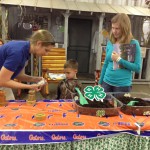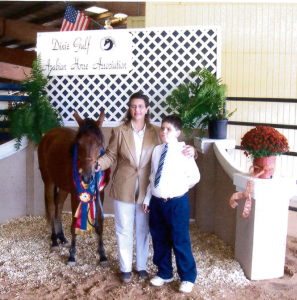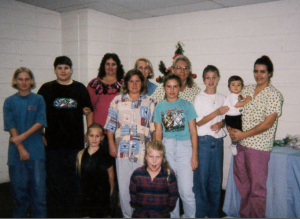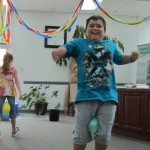by Whitney Cherry | Aug 28, 2015
 Research shows that 20-40% of children are bullied in some way. Whether bullying is verbal, physical, or done online it is a very real problem that can happen in any school, even among young school-age children. A safe and secure environment is key for the Essential Element of Belonging, one of the foundations of 4-H positive youth development. Being educated about what bullying is, knowing how to spot the signs of bullying, and learning what to do if your child is affected by this behavior can help parents address bullying if and when it happens.
Research shows that 20-40% of children are bullied in some way. Whether bullying is verbal, physical, or done online it is a very real problem that can happen in any school, even among young school-age children. A safe and secure environment is key for the Essential Element of Belonging, one of the foundations of 4-H positive youth development. Being educated about what bullying is, knowing how to spot the signs of bullying, and learning what to do if your child is affected by this behavior can help parents address bullying if and when it happens.
How to recognize bullying- Bullying can take several forms. It can be observable or secretive behavior.
| Observable Behavior: |
Secretive Behavior: |
- Intimidation and threats.
- Name calling, insults, and comments about disability, gender, and race.
- Teasing about personal characteristics or sexual harassment.
- Physical assault, tripping, hitting, pinching and other physical abuse.
- Destruction of property, demanding money or other possessions.
|
- Rejecting, excluding, and isolating victims from others.
- Spreading rumors and other public humiliation.
- Manipulating friends and relationships, passive aggression.
- Passing damaging notes or posting threatening or damaging emails or web material.
- Blackmailing, harassment, and dangerous dares.
|
Left unaddressed, bullying can cause depression and lasting psychological damage to the victim. It can result in poor attendance or psychosomatic illnesses. Violence can escalate into serious property damage, and injuries to students and adults. Bullying at school also affects others who are not involved directly but who simply witness or are aware of mistreatment of another student. These students may suffer from fear and concern about their schoolmate who is targeted. They may feel guilt but also may fear the bully so much that they do nothing to help. Worse, they may become offenders themselves because they fear the perpetrator will target them.
Bullies tend to seek out victims who:
- Are unable to defend themselves.
- Have little social support, or few friends.
- Are not involved in extra-curricular activities.
- Are low achievers in academics or sports.
- Are not popular or focused on by adults in the school.
- Have less developed social skills.
- Have difficulty communicating.
- Have low-self esteem or are unassertive.
Know the warning signs of bullying- It is not uncommon for a child who may be the victim of school bullying to be reluctant to tell his or her parents out of shame or fear. Children fear that the adults will not be able to help them or that they may make the situation worse. They may also believe the bully will retaliate against them or their friends. If you suspect that your child may be a target of school bullying, look for these signs:
- Sadness, anxiety, difficulty sleeping or eating, temper or emotional outbursts, picking on younger siblings.
- Unexplained bruises, cuts, or damaged clothing or school supplies.
- Fear of school, not wanting to go to school, or sudden drop in school performance.
- Dislike of recess and avoidance of unsupervised school areas such as the bathroom, despite the need to go.
- Withdrawal from friends and family, fear of parent communication with teachers.
- Complaints of physical problems without a medical reason.
- Any abrupt behavior change or sudden lack of self-esteem.
What Parents Can Do to Prevent and Stop Bullying –Parents are the key to preventing and stopping bullying. Here are a few ways that parents can help respond to bullying.
Stay connected with your child. The more you know about your child’s friends and their interactions with classmates and peers, the more likely you are to spot any changes in their social circle. Talk with your child every day about specifics at school and extracurricular activities such as what the best or worst part of their day was. This is also an important way to establish good communication with your child so that they can come to you when they have a problem.
Explain to your child what bullying is. Children understand that hitting or pushing another child is wrong, but you can also explain that other forms of bullying, such as excluding or ignoring someone, can also be hurtful.
Tell children what to do in case they experience or witnesses bullying. Talk with your child about the basics of what to do if they encounter hurtful behavior directed toward them or someone else. Tell your child to alert a teacher right away if they see or are subject to bullying behavior, and that it is important to stop someone from getting hurt.
Teach a child the importance of empathy. Research has shown that emotional intelligence and empathy skills may be even more important for success in life than intellectual intelligence. A child who is able to understand what it may feel like to be bullied and can understand and regulate their own emotions is less likely to engage in that kind of behavior.
Set a good example. Do you ever make fun of other people or gossip about others in front of your child? Have you ever spoken rudely to a waiter at a restaurant or to a store clerk in a shop? Even if you think your children are not listening or observing your behavior, the fact is that kids learn a lot about how to conduct themselves from watching their parents.
Talk to your school about what programs are being used to deter bullying. If you suspect that your child may be the victim of school bullying, talk to your child’s teacher about your concerns. Ask the teacher to watch out for problems and notify the school principal and counselor about your concerns as well.
As parents and volunteers, it’s our job to provide youth with a safe environment where they can learn and grow. For more resources about bullying, contact your local UF IFAS Extension Office, or download some of our other resources:
Talking About Bullying
Bullying and Children with Disabilities
Bullying Related to Lack of Time with Dad
Cyberbullying
Outcomes of Bullying
Parent’s Role in Bullying Behavior
Teens and Sexual Harassment: Making a Difference
by Whitney Cherry | May 8, 2015

Photo Credit: Whitney Cherry, UF IFAS Extension
4-H literally got its roots in gardening (pardon the pun). The very first 4-H Clubs focused on growing tomatoes and corn, and many youth and volunteers still enjoy gardening projects today. Gardening enriches your life, promotes good health, and saves money. One way to save money is to make your own paper pots to start your seeds. They are fun and inexpensive to make and are a perfect activity for your next club meeting! For beginners, we recommend growing tomatoes, peppers, eggplant, okra, beans, basil, chives, parsley, and lettuce. Not into vegies? Try starting sunflowers, zinnias, pansies, or petunias instead.
Items you will need:
- Newspaper strips (not glossy inserts)
- Bottle (not glass) or can to wrap paper around
- Seeds and Soil
What to do:
- Cut strips of newspaper about 4” wide.
- Wrap strip of newspaper around an empty juice bottle and roll; try to keep the paper wrapped tightly. Half of the strip of paper should overlap the open end of the bottle.
- Fold the ends of the paper against the bottom of the bottle.
- Push the bottom of the bottle against a flat, hard surface (such as a table) to seal the bottom of your pot.
- Pull the bottle out and you have a finished paper pot. Fill with soil an plant your seeds.
- When the seedling is ready to transplant, simply drop the entire pot into the ground. The newspaper will biodegrade in your garden, and your plant will never be uprooted. Make sure paper is not sticking out of the ground – it will wick water away from the plant if not underground.
You can print a PDF version of the instructions for this activity. Other great gardening resources include:
If you have a green thumb, consider going “totally green” as a 4-H gardening volunteer! 4-H needs caring adults like you to share their knowledge and passion for gardening with the next generation. Through the 4-H gardening project, youth not only learn gardening knowledge and skills, they also learn responsibility, teamwork, and other life skills that will help them grow up to be compassionate and competent citizens. To get involved, contact your local UF IFAS Extension Office, or visit http://florida4h.org./volunteers.
Your opinion matters! Please provide feedback on this short survey to help us improve our blog: https://ufl.qualtrics.com/SE/?SID=SV_3gtLKjqia3F75QN.
by Whitney Cherry | Apr 17, 2015

Dr. Williamson helping a 4-Her at a show
There are many reasons why 4-H has stood the test of time for more than 100 years. In addition to its link with land grant universities, 4-H is family friendly and available in every state and every county in the US (and even some foreign countries like Korea, Cuba, Germany and Italy). In fact, you can be a lifelong participant in 4-H- first as a youth member, then as a collegiate 4-H member, and later as an alumni or volunteer. Dr. Reese Williamson is a great example of how to turn a 4-H experience as a youth into a lifelong passion. She joined 4-H in 1974, in McKean County, Pennsylvania and was active in horse clubs, livestock clubs, downhill ski clubs, and even a square dancing club! As a teen, she fine-tuned her communication and leadership skills as a member of the 4-H County Council, which later led to a summer internship as the 4-H Assistant to the County agent. “My 4-H Extension Agent in Pennsylvania was a motivator and wrote recommendation letters for me for college and vet school,” says Dr. Williamson. “I have been involved in 4-H since 1974 with the exception of the five years while I was in vet school. As soon as I moved to Florida, I looked up my local county Extension Office to become a volunteer.”
When asked why she decided to extend her 4-H involvement as a volunteer, she says “I enjoy that there is a place for everyone [in 4-H]. I enjoy sharing the joy of learning and of livestock and horses with youth. It’s important that youth know where their agricultural products come from, that they respect animals and the impact they have on the environment. I want them to have a positive experience with horses and other animals.”

Dr. Williamson with members and alumni of her 4-H club
Without volunteers like Dr. Williamson, many youth would not have opportunities to learn about agriculture or develop life skills such as responsibility, confidence, and compassion. She shares, “It’s challenging to be a youth volunteer in today’s society. Most youth are from single-parent families. Children are living in two homes with multiple parents and grandparents often creates scheduling conflicts, but we must put the children first- they are the priority. It’s important to me to never disappoint or extinguish a child’s enthusiasm. If a child works towards a goal, it’s important that they are not prevented from completing that goal because of a scheduling boundary.”
Dr. Williamson’s passion for helping youth has had a tremendous impact on the Okaloosa 4-H Program over the past 25 years. Many of her members have become teen volunteers and later, as adult 4-H Alumni, come back to volunteer.
Kyle Godwin, an Okaloosa 4-H Alumni says, “Over the years of being in Dr. Williamson’s 4-H club, both as a member and then as the Club President , she laid many building blocks for me from public speaking to proper animal husbandry. She is always willing to go out of her way to help a new kid get started raising animals.” Another 4-H Alumni, Nathan Moores, shares: “Dr. Williamson has been a dedicated volunteer throughout my 4-H experience and we are blessed to have her. She has gone out of her way to help me and my fellow 4-Hers with our projects, whether it was husbandry questions, vaccinations, or health certificates.”
Do you have a passion or skills that you would like to pass on to the next generation of parents, employees, civic leaders, and decision makers? Dr. Williamson’s advice to anyone considering getting involved is: “Step up and volunteer! With 4-H, you can have a positive influence on our next generation of citizens. It is definitely worth squeezing the time into your schedule.” You don’t have to be a 4-H Alumni or a veterinarian to volunteer. 4-H needs caring adults from a wide variety of backgrounds, skills and experiences. For more information, contact your local UF IFAS Extension Office, or visit http://florida4h.org/volunteers.
Your opinion matters! Please take this short survey to help us improve our blog https://ufl.qualtrics.com/SE/?SID=SV_3gtLKjqia3F75QN
by Whitney Cherry | Feb 6, 2015

Don’t let the weather ruin your club’s recreational time. Play inside!
It’s that time of year in North Florida when we’re not sure what we’ll wake up to each morning. We may be in short sleeves, sweatshirts, or hip waders and that can make planning a club meeting tough. During this time of year, between the cold and the rain, it’s seldom that our youth are allowed to go outside for PE. And in lower grades, where a gym may not be available, they are often not getting any significant amount of physical activity during the school day. This is neither good for their mental or physical health, so how can we combat the winter-blues in our club meetings? Here are a few suggestions:
Indoor relay and tag games: If space permits, move the furniture out of the way, and let the kids play freeze tag or have a relay race. Relays are often easy to relate to the educational topic of your meeting. Examples include:
- Set the table relay: where youth draw a piece of a table setting out of a paper bag, run to a table across the room, and put it in its proper place on the table. (the floor can be used in place of a table if need be.) The first team to correctly set the table wins.
- Salsa relay: youth put plastic tomatoes or peppers or onions or garlic between their knees and “run/waddle” around a cone, chair, or tape mark, at the other end of the room back to their team where they pass on their piece of food to the next team mate. The first team to have each player complete the task wins.
- Traditional balloon and ring races are always good too.
Exercise bingo: Contact your local extension office for a copy of exercise bingo. In this high intensity game, each youth or team of youth, is given a bingo card and a stack of exercise cards which face down on the floor. A teammate flips an exercise card, and each team member completes the task on the card (arm circles, pushups, jumping jacks, etc.) If their bingo card includes this exercise, the team captain marks that spot off of their card. Teammates take turn flipping exercise cards until they have Bingo. The first team to get Bingo wins.
Simon Says, Duck-Duck-Goose, London Bridge: These games require only a little space, and are still fun for younger youth, especially Cloverbuds (4-7 yrs). Simon says can often relate to your educational program as well. Ex – “Simon says comb your steer.” “Simon says, stir the batter.” “Simon says bait your hook.”
Legos, board games, etc.: It’s not very active, we know, but sometimes space just doesn’t allow for much physical activity, but it’s still important for youth to have time to interact with each other and relax. Be sure not to pick board games that may take hours to complete. Things like Charades, Guestures, Win, Lose or Draw, etc. are great options.
Now it’s your turn. Get creative, and in the comments section below, share with us the ideas you have for indoor recreation!
by Whitney Cherry | Jul 1, 2014
Article by guest blogger, Georgene Bender (South Central Regional Specialized 4-H Agent)

Photography by David Perkiewcz,, The Cleveland Plain Dealer
Photography is a popular 4-H project and this time of year, it is fun to experiment taking pictures of fireworks and sparklers. With helpful tips you will be amazed at what you can do. Let’s review some basics. The word “photography” means drawing with light….so the key is the amount of light needed for these unique shots. Basically there are two camera types a) point & shoot and b) Digital Single-lens reflex. Each camera type has various features. It is good to familiarize yourself with them in the Menu or camera manual. What? You don’t have that book anymore. No problem – search for it online.
Focus on Infinity- Set your focus to just less than infinity (or choose a landscape setting if you can’t manually adjust focus) and use an aperture of f/8 t- f/16.
Equipment- Be sure to take a small flashlight to adjust your settings in the night and a sturdy tripod – this is the best to reduce movement and blurred photos. Another great tool for the SDLR is the cable release cord that you can control the shutter’s button or the digital remote. Digital cameras will have a setting.
Bust Shooting- Also known as ‘continuous drive’ allows you to shoot multiple shots automatically. On a DSLR go to your menu and select Self-timer and you will see two options inside. A) Self-timer delay allows you to set time after how many seconds camera should take a shot and available values are 2s, 5s, 10s, and 20s. B) Number of shots you want to take in self-timer mode. You can choose between 1 and 9 shots.
Five Top Tips:
- Observe the wind direction from where you are. Pick a location upwind so that your photos do not turn out hazy.
- Pack extra batteries and memory cards- long exposures drain battery life, and you will need to shoot lots of pictures to get a few great shots.
- Watch for the fireworks as they travel and push and hold the release button. (This will take time to practice – and also the bust shooting will help for better capture)
- Learn more online. A couple of good sources include the Walt Disney World (WDW) Photography series. There are YouTube videos by Cory Disbrow from WDW Photography.com http://youtu.be/yZh_ADUsgrY and http://wdwphotography.com.
- Practice playing with light before the fireworks by having friends ‘air write’ their name with the flashlight or sparklers. You, with your trusty tripod and camera settings shoot pictures. You will be amazed at what you get.
This chart below gives you the areas of each camera type to prepare before shooting.
|
SETTINGSMenu screen or, Bulb |
SHUTTERControls the open/close of light into camera |
ISOSensitivity of the light |
FLASHArtificial light |
APERTUREControls amount of light |
| Point and Shoot |
Manual(Check your manual as compact cameras have this as a menu optionLook for information on a delay release timer. |
Keep open for 10– 30 seconds; find your ‘night setting’ might be a half moon with starsThere is no B setting on Compact Cameras |
Lowest it will go |
OFF |
N/A |
| DSLR |
M = MANUALB= BULBTurn on noise reduction
Delay release setting |
On B setting, you can hold the camera button for as long as you want10 – 60 sec then went you release the button the shutter will close out the light. |
100 or lower |
OFF |
Changing the aperture is changing the f-stop.Set between f2.8 and f8
The lower the f-stop the more light |

Photo by Jill Wellington
Take lots of pictures this weekend– and please SHARE your best shot on our blog, Facebook, or Twitter! To learn more about the 4-H Photography Project and Contests, visit http://florida4h.org/programsandevents_/photo/photo-contest-resources/. If you have a passion for photography, consider serving as a 4-H photography project leader or becoming a sponsor of your local 4-H photography program. For more information, contact Heather Kent at hckent@ufl.edu.
Credits to:
Fleenor, S., Asdtroth, K. and Peters, C. 2010. “Catch the Spark” University of Arizona Extension 4-H Youth Development.
“How to Take Multiple Shots in Self-Timer Mode.” http://www.dailyphotographytips.net/question-answer/how-to-take-multiple-shots-in-self-timer-mode/
Harnocz, A. July 1, 2014 “How to Photography Fireworks” The Cleveland Plain Dealer. http://www.cleveland.com/interact/2014/07/how_to_photograph_fireworks_5.html
 Research shows that 20-40% of children are bullied in some way. Whether bullying is verbal, physical, or done online it is a very real problem that can happen in any school, even among young school-age children. A safe and secure environment is key for the Essential Element of Belonging, one of the foundations of 4-H positive youth development. Being educated about what bullying is, knowing how to spot the signs of bullying, and learning what to do if your child is affected by this behavior can help parents address bullying if and when it happens.
Research shows that 20-40% of children are bullied in some way. Whether bullying is verbal, physical, or done online it is a very real problem that can happen in any school, even among young school-age children. A safe and secure environment is key for the Essential Element of Belonging, one of the foundations of 4-H positive youth development. Being educated about what bullying is, knowing how to spot the signs of bullying, and learning what to do if your child is affected by this behavior can help parents address bullying if and when it happens.





